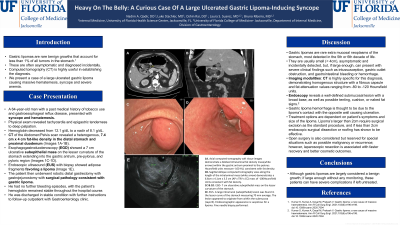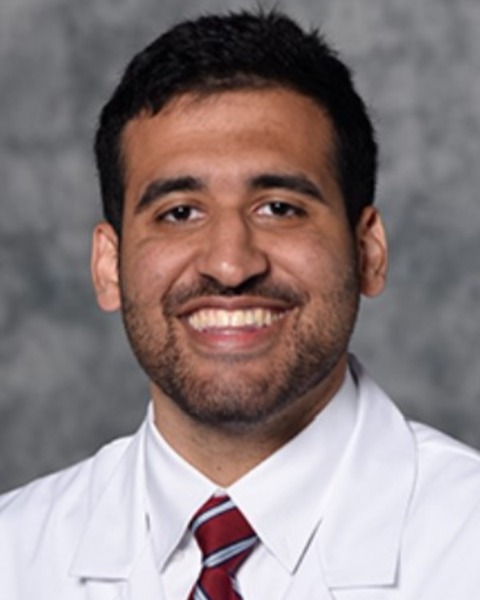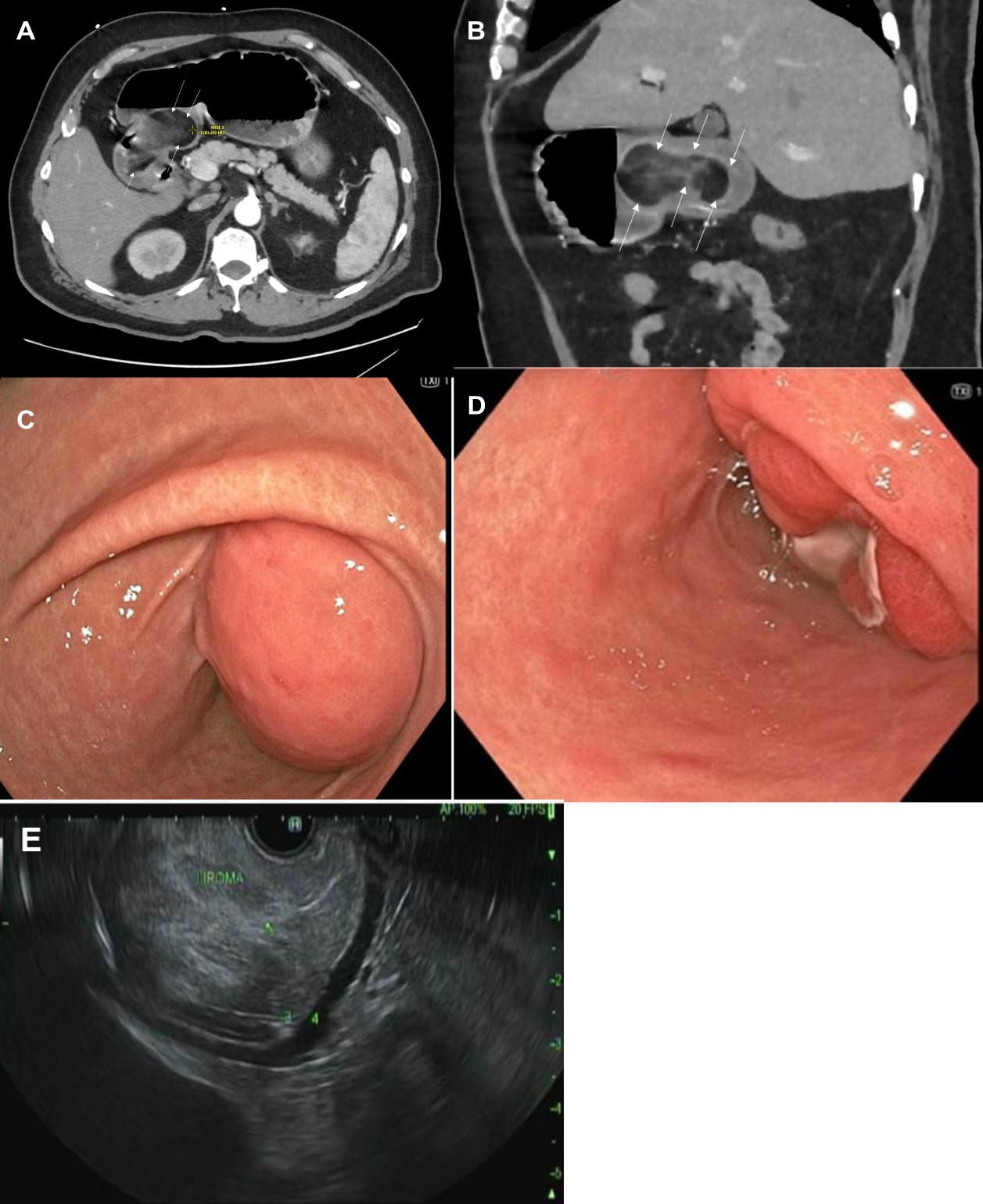Monday Poster Session
Category: Stomach
P3419 - Heavy on the Belly: A Curious Case of a Large Ulcerated Gastric Lipoma-Inducing Syncope
Monday, October 28, 2024
10:30 AM - 4:00 PM ET
Location: Exhibit Hall E

Has Audio

Nadim A. Qadir, DO
University of Florida College of Medicine
Windermere, FL
Presenting Author(s)
Nadim A. Qadir, DO1, Luke Stachler, MD2, Oshin Rai, DO2, Laura Suzanne K. Suarez, MD3, Bruno Ribeiro, MD2
1University of Florida College of Medicine, Windermere, FL; 2University of Florida College of Medicine, Jacksonville, FL; 3University of Florida, Jacksonville, FL
Introduction: Gastric lipomas are rare benign growths that account for < 1% of all tumors in the stomach. These are often asymptomatic and diagnosed incidentally. We present a case of a large ulcerated gastric lipoma causing massive hematemesis, syncope and severe anemia.
Case Description/Methods: A 64-year-old man with a past medical history of tobacco use and gastroesophageal reflux disease, presented with syncope and hematemesis. Physical exam revealed tachycardia and epigastric tenderness to deep palpation. Hemoglobin decreased from 12.1 g/dL to a nadir of 8.1 g/dL. Computed Tomography (CT) of the Abdomen/Pelvis scan revealed a heterogenous, 7.4 cm x 4 cm fat-like density in the distal stomach and proximal duodenum (Images 1A-1B). Esophagogastroduodenoscopy (EGD) showed a 7 cm ulcerative subepithelial mass on the lesser curvature of the stomach extending into the gastric antrum, pre-pylorus, and pyloric region (Images 1C-1D). Endoscopic ultrasound (EUS) with biopsy showed adipose fragments favoring a lipoma (Image 1E). Robotic distal gastrectomy with gastrojejunostomy was done with surgical pathology consistent a gastric lipoma. He had no further bleeding episodes and discharged in stable condition.
Discussion: Gastric lipomas are rare extra mucosal neoplasms of the stomach, most commonly detected in the 5th or 6th decade of life. They are usually small (< 4cm), asymptomatic and incidentally detected, but, if large enough, can present with severe clinical findings such as intussusception, gastric outlet obstruction, and gastrointestinal bleeding or hemorrhage. CT is highly specific for this diagnosis, demonstrating homogenous structure with a fibrous capsule and fat attenuation values ranging from -80 to -120 Hounsfield units. Endoscopy reveals a well-defined submucosal lesion with a broad base, as well as possible tenting, cushion, or naked fat signs. Gastric lipoma hemorrhage is thought to be due to the lipoma’s contact with the opposite wall causing ulceration. Treatment options are dependent on patient’s symptoms and size of the lipoma. Lipoma’s larger than 2cm require surgical excision as the standard procedure, and if less than 2cm endoscopic surgical dissection or roofing has shown to be effective. Open surgery is also considered but reserved for special situations such as possible malignancy or recurrence; however, laparoscopic resection is associated with faster recovery and better cosmetic outcomes.

Disclosures:
Nadim A. Qadir, DO1, Luke Stachler, MD2, Oshin Rai, DO2, Laura Suzanne K. Suarez, MD3, Bruno Ribeiro, MD2. P3419 - Heavy on the Belly: A Curious Case of a Large Ulcerated Gastric Lipoma-Inducing Syncope, ACG 2024 Annual Scientific Meeting Abstracts. Philadelphia, PA: American College of Gastroenterology.
1University of Florida College of Medicine, Windermere, FL; 2University of Florida College of Medicine, Jacksonville, FL; 3University of Florida, Jacksonville, FL
Introduction: Gastric lipomas are rare benign growths that account for < 1% of all tumors in the stomach. These are often asymptomatic and diagnosed incidentally. We present a case of a large ulcerated gastric lipoma causing massive hematemesis, syncope and severe anemia.
Case Description/Methods: A 64-year-old man with a past medical history of tobacco use and gastroesophageal reflux disease, presented with syncope and hematemesis. Physical exam revealed tachycardia and epigastric tenderness to deep palpation. Hemoglobin decreased from 12.1 g/dL to a nadir of 8.1 g/dL. Computed Tomography (CT) of the Abdomen/Pelvis scan revealed a heterogenous, 7.4 cm x 4 cm fat-like density in the distal stomach and proximal duodenum (Images 1A-1B). Esophagogastroduodenoscopy (EGD) showed a 7 cm ulcerative subepithelial mass on the lesser curvature of the stomach extending into the gastric antrum, pre-pylorus, and pyloric region (Images 1C-1D). Endoscopic ultrasound (EUS) with biopsy showed adipose fragments favoring a lipoma (Image 1E). Robotic distal gastrectomy with gastrojejunostomy was done with surgical pathology consistent a gastric lipoma. He had no further bleeding episodes and discharged in stable condition.
Discussion: Gastric lipomas are rare extra mucosal neoplasms of the stomach, most commonly detected in the 5th or 6th decade of life. They are usually small (< 4cm), asymptomatic and incidentally detected, but, if large enough, can present with severe clinical findings such as intussusception, gastric outlet obstruction, and gastrointestinal bleeding or hemorrhage. CT is highly specific for this diagnosis, demonstrating homogenous structure with a fibrous capsule and fat attenuation values ranging from -80 to -120 Hounsfield units. Endoscopy reveals a well-defined submucosal lesion with a broad base, as well as possible tenting, cushion, or naked fat signs. Gastric lipoma hemorrhage is thought to be due to the lipoma’s contact with the opposite wall causing ulceration. Treatment options are dependent on patient’s symptoms and size of the lipoma. Lipoma’s larger than 2cm require surgical excision as the standard procedure, and if less than 2cm endoscopic surgical dissection or roofing has shown to be effective. Open surgery is also considered but reserved for special situations such as possible malignancy or recurrence; however, laparoscopic resection is associated with faster recovery and better cosmetic outcomes.

Figure: 1A. Axial computed tomography soft tissue images demonstrate a bilobed intraluminal fat density mass (white arrows) within the gastric antrum proximal to the pylorus. Hounsfield units measure -100 HU, consistent with fat density.
1B. Sagittal oblique computed tomography view along the length of the intraluminal mass (white arrow) demonstrates a 6.6cm x 4.1cm x 3.5 cm (AP x TRV x CC) mass of -100 Hounsfield Units consistent with fat density.
1C & 1D. EGD- 7 cm ulcerative subepithelial mass on the lesser curvature of the stomach.
1E. EUS- A large intramural (subepithelial) lesion was found in the lesser curve of the stomach measuring 70
mm average. The lesion appeared to originate from within the submucosa (Layer 3). Endosonographic appearance is
suspicious for a lipoma. Fine needle biopsy performed.
1B. Sagittal oblique computed tomography view along the length of the intraluminal mass (white arrow) demonstrates a 6.6cm x 4.1cm x 3.5 cm (AP x TRV x CC) mass of -100 Hounsfield Units consistent with fat density.
1C & 1D. EGD- 7 cm ulcerative subepithelial mass on the lesser curvature of the stomach.
1E. EUS- A large intramural (subepithelial) lesion was found in the lesser curve of the stomach measuring 70
mm average. The lesion appeared to originate from within the submucosa (Layer 3). Endosonographic appearance is
suspicious for a lipoma. Fine needle biopsy performed.
Disclosures:
Nadim Qadir indicated no relevant financial relationships.
Luke Stachler indicated no relevant financial relationships.
Oshin Rai indicated no relevant financial relationships.
Laura Suzanne Suarez indicated no relevant financial relationships.
Bruno Ribeiro indicated no relevant financial relationships.
Nadim A. Qadir, DO1, Luke Stachler, MD2, Oshin Rai, DO2, Laura Suzanne K. Suarez, MD3, Bruno Ribeiro, MD2. P3419 - Heavy on the Belly: A Curious Case of a Large Ulcerated Gastric Lipoma-Inducing Syncope, ACG 2024 Annual Scientific Meeting Abstracts. Philadelphia, PA: American College of Gastroenterology.
